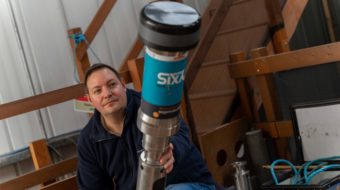Titan Survey Opts for Two More Boomers

Titan Survey has been involved in marine surveys both in the UK and worldwide for over 30 years and is increasingly involved in offshore renewable energy schemes, particularly wind farm projects, where an accurate interrogation of the subsea geology is so crucial to turbine foundation design, as well as route selection for the cabling to shore. The company has found the Applied Acoustics seismic survey equipment, the CSP energy supply and sound source known as a boomer, particularly useful for this near shore sub-bottom survey work.
“We use an Applied Acoustics bang box and boomer catamaran for a number of different applications and a variety of marine environments from shallow highly turbid esturine waters to deep clear water with strong currents or even high sediment mobility areas such as the Bristol Channel,” said Chief Surveyor Matt Ireson, “so we absolutely know the versatility of this equipment, but its overriding asset is its small size and weight and how easy it is to switch by hand between vessels. Operating primarily off our small boats, between 9 and 15m, means that we’re quick to mobilise and can easily make use of any third party vessels, allowing an efficient service to our clients.”
Titan’s recent purchase of two further compact CSP-P bang boxes confirms its confidence in the Applied Acoustics’ systems that enable the company to quickly deploy a survey team to any site in the UK and beyond in response to its varied work load.
Being able to offer this sort of flexibility and efficiency alongside excellent data quality has enabled Titan Survey to offer its services to over 20 offshore wind farm projects, including most recently the huge Dogger Bank project, 60 miles east of Scarborough where the surveyors made use of a 1000J seismic power source from Applied Acoustics. If the plans for this windfarm come to fruition some 1800 off-shore turbines will be installed to supply electricity to seven million homes.
In addition to offshore windfarm site pre and post construction surveys, Titan uses its boomer set up to provide sub-surface shallow penetration geology data for many different marine engineering projects such
as cable route and cable landfalls, pipeline routes, tidal lagoon reservoir site surveys and preliminary site surveys for tidal stream turbines. Well suited to Titan’s requirements, this compact sub-bottom profiling equipment sits within the company’s extensive equipment pool that includes tools for hydrometric and marine benthic surveys, as well as equipment for geophysical, hydrographic and topographic coastal surveys.
“These two new seismic power units are considerably smaller than other versions so they offer us the space saving and flexibility we seek without any loss of data quality.” said Matt, “With no reduction in the features offered they are ideal for us.”
The CSP-P unit from Applied Acoustics is part of a family of sub-bottom profiling systems that range in output from 50 to 12,000 Joules. Similar units to the ones owned by Titan Surveys are in operation across the globe for similar surveys in locations such as off Canada’s Atlantic coast, the Baltic and South China Sea.


